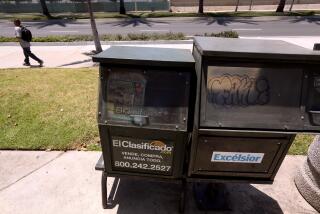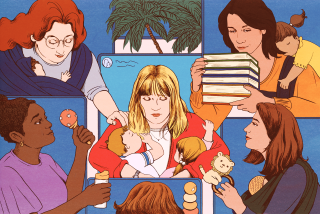The Town Hall Is Beckoning From Your Monitor
- Share via
When the Cantrice Court Homeowners Assn. voted recently to ban skateboarding in their gated Simi Valley community, the skaters’ parents turned to the association’s fledgling Web site to voice their frustration.
Community parents, who felt the board was overstepping its authority, posted messages on the site calling on their neighbors to help overturn the ban. It worked: These messages and a subsequent door-to-door campaign by parents convinced the association to reverse itself.
Association President Michael Harley said if it weren’t for the association’s year-old Web site, time-strapped parents living among the community’s 98 townhomes probably wouldn’t have rallied enough opposition to make themselves heard.
“People are using this thing as a vehicle to incite crowds,” Harley quipped. “It’s like giving people their own newspaper.”
Cantrice Court is one of thousands of homeowners associations and communities that are creating Web sites they hope will entice residents to get involved in their neighborhoods. In the beginning, these sites--most appeared online in the last year--were little more than electronic suggestion boxes and a place to post meeting minutes.
But neighborhood networks are slowly forging a sense of community that many argue has been lost in a time of gated suburbs and double-income families who see little enough of each other--much less their neighbors.
“We’re having this long hand-wringing debate about apathy in public life in America,” said Andrew Cohill, the director of the Blacksburg Electronic Village in Blacksburg, Va. “It’s early, but it looks like it’s actually fairly simple to increase involvement in civic affairs if you take time to show people how to get online.”
More than 87% of the town’s 38,000 residents use Blacksburg’s 7-year-old community intranet, at https://www.bev.org, to shop local businesses’ Web sites and to find out what’s happening in the area. The network highlights the potential for many of today’s fledgling neighborhood networks. The majority of the town’s residents are hooked into the network through high-speed lines.
Technically, neighborhood networks operate in several ways. Intranets like the one in Blacksburg are computer networks that work like the Internet, but are only available to selected people. Most homeowners associations use password-protected Web sites hosted by one of several Internet firms that also provide software to help these groups create their sites.
One of the most popular features on Blacksburg’s intranet is an electronic mailing list that alerts residents to local meetings. Village administrators found that parents who use the network are more likely to attend and to speak up at school board meetings, Cohill said.
Electronic Challenge
Heightened community involvement is taking place in many neighborhoods with electronic networks, said Cohill, who is president of the Assn. for Community Networks, a trade group that tracks trends in community networking.
Most neighborhood networks aren’t nearly as big as Blacksburg’s, but they face similar challenges: convincing residents to sign on and contribute to a neighborhood site, and finding resources to build and maintain it.
Network promoters must often overcome the perception that a Web site will do the opposite of what they want and enable people to sit in front of their PCs and avoid meeting their neighbors. Community network users say this doesn’t happen.
“When I first read the promotional material that said, ‘We’ll use the Internet to bring the community together,’ I thought, ‘If everyone’s in their house using the computer, how does that bring people close together?’ ” said Lisa Williams Scheurenbrand, a sales and marketing manager who lives in Ladera Ranch, a suburb with a community-wide intranet. “But through LaderaLife we met neighbors in other neighborhoods that we may have never gotten around to meeting otherwise.”
Several Internet firms are offering free software to homeowners associations to help them create their own Web sites. The Bell Canyon Assn. interviewed several firms and compared their technologies before it turned to Manhattan Beach-based CommunityPath.com.
“We wanted to bring the neighborhood together as a community,” said Jeff Jost, co-chair of the association’s Internet committee. “Since we’re spread apart it’s easier to use the Internet than to try to use paperwork or to have community meetings.”
Jost said the equestrian neighborhood’s 8-month-old site helped homeowners forge a consensus to lobby Pacific Bell to install fiber optic cables in the canyon that would allow for high-speed Internet access services to be piped into the area.
The site has encouraged the community’s 600 homeowners, who live on large lots and often keep to themselves, to become more active and even led some to suggest that the association hold quarterly town hall meetings, rather than just one annual meeting, Jost said.
Emboldened to Action
Bell Canyon’s site is password protected and only accessible to community members. Other firms provide software that filters obscene and hateful language on neighborhood sites. At eNeighbors.com, users’ names are attached to all messages they post to discourage flaming and anonymous postings.
Far from discouraging use, said John Thillmann, chairman of Reston eVillage in Reston, Va., at restonevillage.org--an intranet designed for the city’s 65,000 residents that uses eNeighbors’ software--this practice actually emboldens homeowners to take action where they might be too shy to do so in person.
“If you were frightened to send a letter to someone in government, it’s generally easier to send an e-mail,” Thillmann said.
Only the most social communities are taking advantage of this technology today, said Nick Richards, president and chief operating officer for the year-old CommunityPath.com. He added that other neighborhoods will come on board when residents can personalize a network to cater to their interests. About 800 communities use the firm’s software today.
For example, a homeowner would be able to sign on to their neighborhood’s site and then choose to link to organizations they’re interested in, such as the Girl Scouts or the golf club, Richards said. CommunityPath.com is building software that would perform this service.
Pioneers of community networks like Cohill are skeptical of the business plans created by many fledgling neighborhood network providers--most of whom rely on advertising money to keep their sites afloat. Blacksburg’s site is administered and supported by Virginia Tech and the town of Blacksburg.
“They have the added baggage of potentially giving away some privacy, and your organization becomes a mechanism for supporting ads,” Cohill said. “We feel it’s important for communities to retain autonomy for services and technology--Boy Scouts should be able to choose to meet in cyberspace that’s free of advertising.”
But Internet firms say that e-commerce can bring positive benefits to neighborhoods. Some networking sites established affinity programs that allow a few cents of every dollar that a user spends at a local online merchant to be donated to their homeowners association.
“Neighborhoods are constantly looking for ways to generate money for new street lights or for Christmas parties,” said Lucia Rambusch-Adam, national director for Neighborhood Link. “If everyone in the neighborhood went shopping everywhere they usually went, they could go to one of these sites and 20 cents would go toward a new jungle gym.”
In a twist on this affinity program, homeowners association members who use eNeighbors are rewarded for using the site with points they can apply toward merchandise at local retailers.
But e-commerce isn’t as popular at the fledgling neighborhood networks as the more social features like bulletin boards, chat and community calendars.
Jill Lenmark didn’t even know what bunco was when she signed up for it on her community’s intranet. Now she plays the game once a month with neighbors who range in age from 25 to 55.
“I work all the way in L.A. every day and it’s a 2 1/2-hour commute,” said Lenmark, a business sales representative who lives in Ladera Ranch. “It would be easy for me to go home and relax, but this was a good way to find out about different clubs and activities.”
*
For previous columns see www.latimes.com/virtual.
More to Read
Sign up for Essential California
The most important California stories and recommendations in your inbox every morning.
You may occasionally receive promotional content from the Los Angeles Times.













